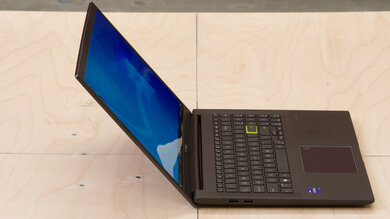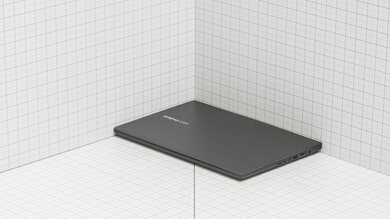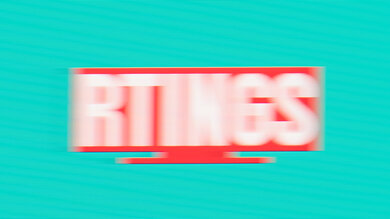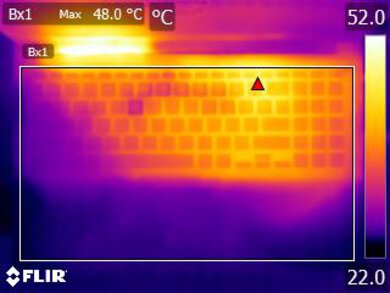The ASUS VivoBook 15 OLED K513 (2021) is an ultraportable Windows laptop. It's available with various Intel 11th Gen. CPUs, up to 16GB of memory, and over 1TB of storage. You can configure it with integrated graphics only or with an NVIDIA GeForce MX330 or MX350 discrete GPU. There's a single display option: a 15.6-inch OLED panel with full DCI P3 and Adobe RGB coverage. Its port selection includes three USB-As, a USB-C, an HDMI, and an SD card reader. It has Wi-Fi 6, Bluetooth 5.2, a 720p webcam, and a fingerprint sensor.
See our unit's specifications and the available configuration options in the Differences Between Variants section.
Our Verdict
The ASUS VivoBook 15 is decent for school use. It has a 15.6-inch screen that provides enough space for light multitasking and gets bright enough for use in most indoor settings. The touchpad tracks well, the webcam's video quality is adequate, and the keyboard is spacious but can be tiring to type on for extended periods. Although it's a compact laptop that's easy to carry around, its battery doesn't last long enough to get through a typical school day, and it doesn't support charging over USB-C, so you'll have to bring the proprietary charger with you.
- Very portable.
- Display gets bright enough for use in most indoor settings.
- CPU can handle most light productivity tasks.
- Adequate webcam video quality for video calls.
- Battery lasts less than seven hours of light productivity.
- Keyboard is tiring to type on for extended periods.
- Integrated and entry-level dedicated GPUs can't handle demanding workloads.
- USB-C doesn't support charging or video output.
The ASUS VivoBook 15 is mediocre for gaming. It's only available with power-efficient Intel 11th Gen processors with integrated or entry-level dedicated GPUs, which aren't powerful enough to handle graphically demanding games. You can play some older or lighter titles on models with a Core i5, i7, or an NVIDIA GPU, but you'll have to play at low settings to get smooth gameplay. While its OLED panel is great for game immersion, it has a basic 60Hz refresh rate and lacks VRR support to reduce screen tearing.
- Fast storage drive.
- Easy to upgrade components.
- Minimal performance loss over time.
- 60Hz refresh rate and no VRR support.
- Integrated and entry-level dedicated GPUs can't handle graphically demanding games.
- Keyboard gets hot under load.
The ASUS VivoBook 15 is decent for media consumption. It has an OLED panel that displays deep blacks, making it fantastic for dark room viewing, and it supports a wide color gamut for HDR content. The speakers get acceptably loud and sound good overall; however, they aren't ideal for listening to music as they lack bass. Unfortunately, even though it's a thin and light device that's easy to carry around, its battery lasts less than five hours of video playback, so you'll have to bring the charger with you.
- Very portable.
- OLED screen displays inky blacks.
- Wide color gamut support.
- Good-sounding speakers.
- Colors look oversaturated in most content.
- Battery lasts less than five hours of video playback.
- Screen doesn't support touch input.
The ASUS VivoBook isn't designed to be used as a workstation. It's only available with low-power CPUs and GPUs, which aren't powerful enough to handle demanding tasks like video editing or 3D animation. You can do some lighter color-correction work, though, as its OLED display has full DCI P3 and Adobe RGB coverage. It doesn't throttle much under load, and you can easily access the internals for repairs and upgrades.
- Fast storage drive.
- Easy to upgrade components.
- Minimal performance loss over time.
- Keyboard is tiring to type on for extended periods.
- Integrated and entry-level dedicated GPUs can't handle demanding workloads.
- Keyboard gets hot under load.
- USB-C doesn't support charging or video output.
The ASUS VivoBook 15 is decent for business use. It's a very portable, thin, and light laptop with Intel 11th Gen CPUs, which can handle tasks like text formatting, web browsing, spreadsheets, and presentations. The webcam's video quality is adequate for video calls, the touchpad is responsive, and the keyboard is spacious but can be tiring to type on for extended periods. Unfortunately, its battery lasts less than seven hours of light productivity, and you can't use its USB-C port to charge the laptop or output a video signal to an external display.
- Very portable.
- Display gets bright enough for use in most indoor settings.
- CPU can handle most light productivity tasks.
- Adequate webcam video quality for video calls.
- Battery lasts less than seven hours of light productivity.
- Keyboard is tiring to type on for extended periods.
- Integrated and entry-level dedicated GPUs can't handle demanding workloads.
- USB-C doesn't support charging or video output.
Changelog
- Updated Feb 23, 2024: We've updated the review for clarity and readability.
- Updated Dec 07, 2023: Converted to Test Bench 0.8.2.
- Updated Nov 03, 2023: Converted to Test Bench 0.8.1.
- Updated Jul 31, 2023: Added mention of the ASUS Vivobook S 16 Flip TP3604 (2023) as an alternative with a sharper display in the Screen Specs section.
Differences Between Sizes And Variants
We tested the ASUS VivoBook 15 OLED K513 (model S513E) with an Intel Core i7-1165G7 CPU, an NVIDIA GeForce MX350 dedicated GPU, 16GB of memory, and 512GB of storage. The CPU, GPU, memory, and storage are configurable; you can see the available options in the table below.
| Screen |
|
|---|---|
| CPU |
|
| GPU |
|
| Memory |
|
| Storage |
|
| Color |
|
See our unit's label here.
Popular Laptop Comparisons
The ASUS VivoBook is a decent ultraportable compared to other models in its class. It stands out for its OLED panel, which displays deep, inky blacks and bright, punchy colors. However, its build quality feels inferior, and its battery life is short.
For more options, check out our recommendations for the best laptops, the best business laptops, and the best laptops for college.
The ASUS VivoBook 15 OLED K513 (2021) is better than the Acer Aspire 3 15 (2023) for most uses. Although the build is similar between these two laptops, the ASUS is more compact and lighter, making it easier to carry around. The ASUS has a significantly better OLED display compared to the Acer laptop's TN panel. The ASUS model's screen gets much brighter, provides a better dark room viewing experience, and has full Adobe RGB and DCI P3 coverage. On the other hand, the Acer has a better port selection, as its USB-C supports charging and DisplayPort Alt Mode.
The LG gram 17 (2021) and the ASUS VivoBook 15 OLED K513 (2021) are both ultraportable laptops with Intel 11th Gen processors. The LG is better for productivity because it has a larger screen for multitasking, a more comfortable keyboard, a more responsive touchpad, and a better webcam for video calls. For media consumption, the ASUS comes out ahead because it has an OLED panel that displays much deeper blacks, and it's more color-accurate out of the box. In terms of battery life, the LG lasts much longer, nearly twice as long for light productivity and video playback. The LG isn't as portable due to its larger size, but it's lighter than the ASUS.
The ASUS Vivobook 16 M1605 (2023) is better than the ASUS VivoBook 15 OLED K513 (2021) for most uses. The M1605 has a better keyboard and touchpad, and its battery lasts longer. However, the K513's OLED display has a higher contrast ratio and a wider color gamut, and it gets brighter to combat glare. The M1605's AMD Ryzen CPUs have better multi-thread performance than the K513's Intel CPUs, but you'll have to get a model with 16GB of RAM or upgrade it yourself to get the most out of its CPU, as the 8GB models run in single-channel mode.
The ASUS Vivobook 15 OLED K513 (2021) and the ASUS Zenbook 14 OLED (2024) are both ultraportables designed for light, general productivity tasks like text processing, web browsing, and video playback. The Zenbook is a more premium model and provides a better user experience overall, while the Vivobook is more of a budget option. As for the Vivobook, it might be a good option if you have a very strict budget; just know that its battery life is quite short at around six hours of light use.
Test Results

The ASUS VivoBook has a simple, basic-looking design, with a bright green accent color around the Enter key to give it a slight gamer flair. On the bottom, you can find the speakers near the front and the exhaust vents near the back. This laptop is available in three color schemes: Indie Black, Transparent Silver, and Hearty Gold.
The ASUS VivoBook's build quality is okay. The back of the display is metal, but the rest of the laptop is plastic. It doesn't feel particularly sturdy as there's a fair amount of flex in the keyboard deck and display, and the screen itself bends slightly inwards. Also, the chassis' finish feels slippery and easily picks up oil from handling. The feet stick firmly to the bottom, though, and the hinge feels strong.
The hinge is okay. It feels smooth when opening and closing the laptop, and it's stable, with very little play. The screen doesn't wobble even when typing aggressively. However, you can't open the laptop with one finger as there isn't enough weight in the base to prevent it from lifting with the display.
The serviceability is great. Accessing the internals is easy as you only need to remove nine Philips screws and pry open the bottom panel with a pick or prying tool. There's space for a 2.5-inch SATA drive, but there isn't a mounting cable in the box, so you have to find a third-party solution if you want to add a second storage drive.
The screen is decently sharp and provides enough space for light multitasking. Its standard 16:9 aspect ratio is great for viewing videos, but some may find it too short for productivity as you have to scroll more when reading a document or website. Like all OLEDs, there's a risk of permanent burn-in with static elements like Windows' taskbar; however, it's unlikely to be an issue for those viewing varied content. If you want a similar laptop with a sharper display, check out the ASUS Vivobook S 16 Flip TP3604 (2023), which is available with a 3.2k OLED screen.
The ASUS VivoBook has a basic refresh rate typical of most thin and light productivity laptops. While most OLEDs have a near-instantaneous response time, this panel is a bit slow, causing visible ghosting behind fast-moving objects. That said, it's still better than most IPS or TN panels on similar types of laptops.
The display gets bright enough for use in most indoor settings but not outdoors in broad daylight. Unfortunately, it doesn't get any brighter in the Vivid color profile. It gets very dim at the lowest brightness settings, which is great for dark room viewing as it causes less eye strain.
The display's reflection handling is okay. It struggles mainly with direct reflections, so it's best to avoid having bright lights right behind you. The reflections look warped in the photo because there's a slight bend in the display.
The display's horizontal viewing angle is decent. Colors quickly shift as you move off-center and wash out at steeper angles. However, you can still share the screen with someone else as long as you don't need perfect image accuracy.
The display's vertical viewing angle is decent. The image looks warmer from above and below as it gains a reddish tint. It isn't too bad if you're only viewing documents, but you have to look at the screen more or less straight on if you need accuracy for color-critical work.
The display's accuracy is decent out of the box. The white balance is excellent, but most colors look oversaturated because it targets a wide color space, even in sRGB content. Some people may like the oversaturated look; it just isn't very accurate. The color temperature is only slightly warmer than the standard 6,500K target, which is not enough to make much of a difference. The gamma doesn't follow the sRGB curve, making most scenes appear darker than intended. The posted results are measurements taken in the Standard color profile; here are the numbers for the Vivid color profile:
- Average White Balance: 2.85
- Average Gamma: 1.92
- Average Color dE: 3.85
- Average Color Temperature: 6,357
Colors look more accurate in the Vivid color profile, but the image is too bright.
The display's color gamut is outstanding. It has full coverage of the sRGB, Adobe RGB, and DCI P3 color spaces, and its Rec. 2020 coverage is great. It's suitable for professional photo editing as well as for viewing and producing SDR and HDR content.
The ASUS VivoBook K513 has a decent keyboard. The keys feel good and have sufficient spacing between them. However, they're not the most stable, and they require a fair amount of force to actuate, making them tiring to type on for extended periods. You can toggle through three backlight brightness levels or turn it off completely.
The ASUS VivoBook 15 OLED's touchpad is decent. It's on the smaller side, but it tracks all movements and gestures well, and there aren't any palm rejection issues. You can only click towards the bottom of the touchpad, though.
This laptop has good speakers. They get acceptably loud, with minimal dynamic compression at max volume. Its mid-heavy sound profile results in very forward vocals, which is good for spoken content, but the lack of bass makes them less ideal for listening to music or watching movies.
The webcam's video quality is okay. The image has some fine details and good color reproduction but has an unnatural hue. Speech sounds decently clear over the microphone, with very little background noise. There isn't a physical privacy cover; however, there's a button to disable the camera at the software level.
The port selection is decent. The USB-A port on the right side supports USB 3.2 Gen 1 data transfer speed (up to 5Gbps), but the two on the left are only USB 2.0 ports (up to 480Mbps). The USB-C only supports data at USB 3.2 Gen 1 speed, so you can't use it to charge the laptop or output a video signal to an external display. The HDMI port's maximum output resolution is 4k @ 30Hz.
The wireless adapter is an Intel Wi-Fi 6 AX201. Some models only support Wi-Fi 5 and Bluetooth 4.1.
The ASUS VivoBook is available with the following CPUs:
- Intel Core i3-1115G4 (2 cores/4 threads, up to 4.10GHz)
- Intel Core i3-1125G4 (4 cores/8 threads, up to 3.70GHz)
- Intel Core i5-1135G7 (4 cores/8 threads, up to 4.20GHz)
- Intel Core i7-1165G7 (4 cores/8 threads, up to 4.70GHz)
All of the available CPUs are low-power processors designed for general productivity tasks like text processing, web browsing, and video playback. The i3-1115G4 is the lowest-end configuration with 2 cores and 4 threads, while all other options are 4-core, 8-thread CPUs. For most people, the base Core i3 configuration is powerful enough to provide a smooth desktop experience. However, it's best to upgrade to one of the quad-core CPUs if you tend to have multiple browser tabs or applications open at once or need to perform more demanding tasks. Upgrading from an i3-1125G4 to an i5-1135G7 will provide a slightly snappier experience, and the same goes for upgrading from the Core i5 to an i7-1165G7. That said, the performance increase is minimal and only noticeable if you push the CPUs to their maximum capacity.
The ASUS VivoBook is available with the following GPUs:
- Intel UHD Graphics (integrated, Core i3)
- Intel Iris Xe Graphics (integrated, Core i5 and i7)
- NVIDIA GeForce MX330 2GB GDDR5 (dedicated)
- NVIDIA GeForce MX350 2GB GDDR5 (dedicated)
The integrated graphics will depend on which CPU you get. The Core i3s have Intel UHD Graphics for 11th Gen processors with 48 execution units, the Core i5 has Intel Iris Xe Graphics with 80 execution units, and the Core i7 has Intel Iris Xe Graphics with 96 execution units. There are two NVIDIA GPUs: the NVIDIA GeForce MX330 and the MX350; both have 2GB of GDDR5 VRAM.
All the GPU options can handle simple, everyday tasks like web browsing and video playback. The Core i5 and i7's Iris Xe Graphics and the dedicated NVIDIA GPUs perform fairly similarly, though the NVIDIA GPUs are slightly better in VRAM-heavy applications. Aside from the Core i3s' integrated graphics, they can all handle some light gaming, but you'll have to play at low settings in most titles to get smooth gameplay.
You can configure this laptop with 4GB, 8GB, 12GB, or 16GB of RAM. The recommended minimum is 8GB because 4GB is barely enough for the operating system and will cause slowdowns if you have many programs running simultaneously. The 8GB models can be in single-channel (8GB soldered + 1 empty SO-DIMM slot) or dual-channel mode (4GB soldered + 4GB SO-DIMM), so if you don't plan on adding a RAM module yourself later on, it's best to get the model that has the dual-channel memory as it'll perform better.
You can configure this laptop with a PCIe NVMe SSD only or a combination of an NVMe SSD and a 1TB 2.5-inch 5400RPM physical hard drive. If you get a model with an SSD only, you have three choices: 256GB, 512GB, or 1TB. The 2.5-inch hard drive is only available in combination with a 128GB or 256GB PCIe NVMe SSD.
The ASUS VivoBook's Intel Core i7-1165G7 scores well in Geekbench 5. That said, it's an older CPU, and there are newer, significantly faster processors on the market, especially when it comes to multi-thread performance. The i7-1165G7 can handle general productivity tasks without many issues, but don't expect to do anything intensive. As for its GPU compute performance, the NVIDIA GeForce MX350 performs poorly and isn't suitable for demanding workloads.
The Intel Core i3-1115G4 will perform significantly worse, especially in multi-threaded workloads, while the i3-1125G4 and i5-1135G7 will only be slightly slower. None of the GPU options are ideal for demanding tasks like image processing or photo editing.
The ASUS VivoBook has mediocre performance in Blender. It takes far too long to render images, whether you use the CPU or the dedicated NVIDIA GPU. None of the CPU or GPU configurations are ideal for professional 3D rendering. If you need to render images, it's best to get a laptop with a more powerful NVIDIA RTX 30- or 40-series GPU, or an Apple MacBook Pro with Apple silicon.
The ASUS VivoBook 15 performs poorly in the Basemark GPU benchmark. Although the NVIDIA GeForce MX350 is a discrete GPU, it doesn't have the processing power to handle demanding games. You can play some lighter platformers, puzzle-like games, or older titles, but you'll have to play with low settings or a lower resolution to get smooth gameplay. The other configurations will perform worse.
If you get a model with a physical hard drive, it's best to install your applications on the SSD along with the operating system and only use the hard drive as mass storage. Otherwise, it can make the computer feel sluggish. Storage drive speed varies depending on the drive's size, as larger SSDs tend to perform better.
These results are for the top-end, most power-hungry configuration with an Intel Core i7-1165G7 CPU and a dedicated NVIDIA GeForce MX350 GPU. The other models will likely have a longer battery life. If you need a similar laptop with all-day battery life, check out the Dell Inspiron 16 2-in-1 (2023).
Borderlands 3 runs terribly on the ASUS VivoBook 15, as it's very choppy, even at the lowest graphical settings. None of the configurations can run this game smoothly.
Civilization VI runs poorly on the top-end ASUS VivoBook with an Intel Core i7-1165G7 and NVIDIA GeForce MX350. It's playable if you turn down some graphical settings; however, the average turn time is long. The Core i5 and i7 models with integrated graphics or an NVIDIA GeForce MX330 will perform similarly. The Core i3 models with integrated graphics will perform significantly worse, but the game will likely still be playable at the lowest graphical settings.
The ASUS VivoBook 15 runs CS:GO well. The gameplay is smooth at high graphical settings, with only a few occasional stutters. The Core i7 models with integrated graphics will perform similarly, and the same goes for the NVIDIA GeForce MX330 and MX350 models. The Core i5 with integrated graphics will perform worse, but it'll still be playable, while the Core i3s with Intel UHD graphics will perform significantly worse, similar to the HP Pavilion x360 14 (2021).
Shadow of the Tomb Raider runs terribly on the ASUS VivoBook 15. The average frame rate is too low to be playable at high graphical settings, even on the top-end configuration with an Intel Core i7-1165G7 and NVIDIA GeForce MX350. You'll have to play with low settings or at 720p for smooth gameplay. Models with an NVIDIA GeForce MX330 or an Intel Core i7's Iris Xe Graphics will perform fairly similarly. The Core i3 and i5 models with integrated graphics will perform worse or not run the game.
The ASUS VivoBook has decent thermal and noise handling. The keyboard deck is cool when idle, but it gets hot under load, with the hottest spot being just above where most people rest their right hand. The fan isn't audible when idle unless you put your ear right next to the laptop, and while it's noticeable under load, it's mostly the sound of heavy airflow rather than an annoying, high-pitch whine.
The ASUS VivoBook comes with Windows 10 or 11 installed, depending on the region and the manufacturing date. Some models have Windows in S mode, but you can switch to the full version of the operating system free of charge. You can also get the laptop with the open-source Endless OS or no operating system installed. There are many pre-installed applications, including:
- Disney+: App for the video streaming service.
- DTS Audio Processing: Lets you access the EQ settings and sound profiles for the built-in speakers.
- Microsoft 365: 30-day trial of Microsoft's Office suite and services. Some models include Office Home and Student 2019 or 2021.
- MyASUS: Lets you access power, fan, and display profiles. There's also a noise cancelling feature to reduce background noise during video calls, but it doesn't do much.
- Norton Security Ultra: Trial of Norton Security services. Requires subscription after the trial period ends.
- Skype: Voice and video chat application.
- Solitaire: Card game.
- Spotify: App for the music streaming service.
A fingerprint sensor is located at the top right corner of the touchpad. You can use it to log into Windows quickly, authorize purchases in the Windows Store, or auto-fill saved passwords on supported websites.

































